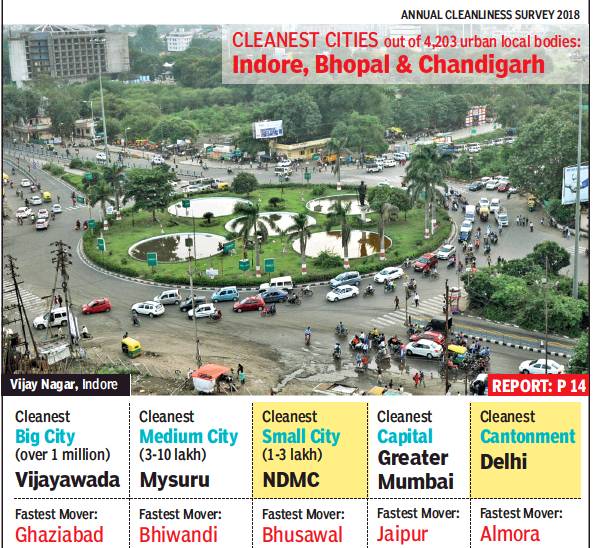Cleanliness ranks of Indian cities, districts: 2018
This is a collection of articles archived for the excellence of their content. |
Contents |
2018 ranks
Graphic: in a nutshell

From: May 17, 2018: The Times of India
See graphic:
The highlights of the annual cleanliness survey, 2018
Individual regions
Bengaluru: Why it is not in the list
HIGHLIGHTS
Experts blame the assessment parameters of Swachh Survekshan for Bengaluru’s poor show
The survey focused more on surface cleanliness rather than ensuring sustainability
The list of cleanest cities in India has been made public by the Union ministry for housing and urban affairs, but Bengaluru has failed to feature among the top three despite being known as the most dynamic city. Why?
This has been the most discussed poser in civic corridors after the Swachh Survekshan 2018 results were declared two days ago. The survey covered 4,041 cities and urban local bodies and the parameters to adjudge cities included collection and transportation of waste, processing and disposal, sanitation, no open defecation and behavioural change brought about by information, education and communication.
Experts blame the assessment parameters for Bengaluru’s poor show, saying more weightage has been given to things like dustbins and hoardings instead of sustainability being achieved via long-term measures. Sandhya Narayan, member of the solid waste management round table, said though the blueprint of the micro plan remained largely on paper, there should have been a special mention of Bengaluru’s waste-processing capacity.
“I don’t think a good ranking could have been expected considering that a turnaround would have to be achieved in just a year. The assessment parameters of the survey are flawed to an extent: A lot of emphasis was given to dustbins in public areas but when waste is not collected and transported, the dustbins overflow and become black spots. The survey focused more on surface cleanliness rather than ensuring sustainability,” she said.
Adding that the feedback section of the survey is also questionable as citizens don’t know much about the ground reality, Narayan highlighted another problem — that of scale. “Cities with a population of 10 lakh can’t be compared to a city housing 100 lakh people. I’m not absolving BBMP of any responsibility, but problems in evaluation exist. We should have got a special mention for our comprehensive micro plan as well as our processing potential, which is presently at 2,300 tonnes,” she said.
The micro plan, launched by the health and solid waste management wing of BBMP’s health department last year, divided each ward into blocks of 750 households with designated facilities for each block.
Door-to-door collection
Swati Singh Sambyal, programme manager, waste management, Centre for Science and Environment, said cities should be evaluated on more than door-to-door collection systems. “In the 52 categories, a majority of the cities are only visibly clean with no appropriate systems for processing and disposal. They continue to indiscriminately dump waste in under-functional processing sites/landfills,” shesaid.
See also
Cleanliness ranks of Indian cities, districts: 2014-15
Cleanliness ranks of Indian cities, districts: 2016
Cleanliness ranks of Indian cities, districts: 2017
Cleanliness ranks of Indian cities, districts: 2018